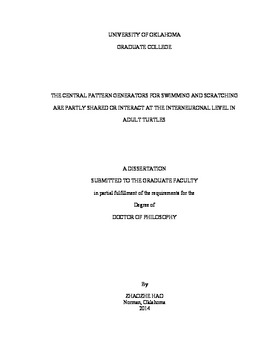| dc.description.abstract | Distinct rhythmic behaviors involving a common set of motoneurons and muscles can be generated by separate central nervous system networks, a single network, or partly overlapping networks in invertebrates. Less is known for vertebrates. Does the spinal cord use a single network to generate distinct rhythms or two separate networks? The turtle spinal cord contains networks that generate swimming as well as three forms of scratching (rostral, pocket, and caudal) with three different knee-hip synergies.
First, I directly compared the adequacy of rostral segments in generating swimming and scratching. I separated caudal segments from immobilized, low-spinal turtles by sequential spinal cord transections. After the separation of the caudal four segments of the five-segment hindlimb enlargement, the remaining enlargement segment and five pre-enlargement segments still produced rhythms for forward swimming and both rostral and pocket scratching. The swimming rhythm frequency was usually maintained. Some animals continued to generate swimming and scratching rhythms even with no enlargement segments remaining, using only pre-enlargement segments. The pre- enlargement segments and rostral-most enlargement segment were also sufficient to maintain hip flexor (HF) motoneuron quiescence between HF bursts, which normally occurs during each hip extensor (HE) phase, during swimming. In contrast, the HF- quiescent phase was increasingly absent (i.e., HE-phase deletions) during rostral and pocket scratching. Moreover, respiratory motoneurons that normally burst during HE bursts continued to burst during the HF quiescence of swimming even with the caudal segments separated. Thus, the same segments are sufficient to generate the basic
rhythms for both locomotion and scratching. These segments are also sufficient to produce a reliable HE phase during locomotion but not during rostral or pocket scratching. I hypothesize that the rostral HE-phase interneurons that rhythmically inhibit HF motoneurons and interneurons are sufficient to generate HF quiescence during HE-biased swimming, but not during the more HF-biased rostral and pocket scratching.
I then simultaneously activated two networks to reveal overlap or interactions between them. The simultaneous stimulation for forward swimming and each form of scratching could 1) increase the rhythm frequency; 2) evoke switches, hybrids, and intermediate motor patterns; 3) reconstruct a swim motor pattern when the swim stimulation was subthreshold, and 4) disrupt rhythm generation entirely. The strength of swim stimulation could influence which effect was obtained. Thus, even pocket scratching and caudal scratching, which do not share a knee-hip synergy with forward swimming, can interact with swim stimulation to alter both rhythm and pattern generation.
Collectively, these findings suggest that the spinal cord networks that generate locomotion and scratching have important shared components or strong interactions between them. If the latter, interactions could occur in motoneurons themselves or earlier, in spinal interneurons. I thus recorded intracellularly from hindlimb motoneurons during dual stimulation. Motoneuron membrane potentials displayed a regular oscillation at a higher frequency than during swim or scratch alone. In contrast, arithmetic addition of the oscillations during swimming alone and scratching alone with various delays always generated irregular oscillations. Also, the standard deviation of the dual-referent phase-normalized membrane potential was similar during dual stimulation and swimming or scratching alone. In contrast, the standard deviation was greater when pooling cycles of swimming alone and scratching alone. This shows that dual stimulation generates a single rhythm prior to motoneurons.
In conclusion, either swimming and scratching share a rhythm generator or the two rhythms are integrated into one by interneurons. | en_US |
